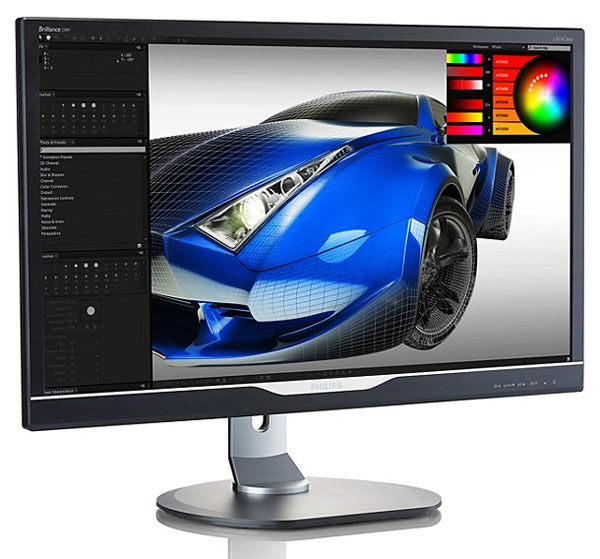Early Verdict
If the 288P6LJEB used the speedy control board found in Asus’ and Planar’s monitors, it would be a winner. If you aren’t looking for a gaming screen, it gets the job done based on perfectly acceptable color performance and excellent build quality.
Pros
- +
Decent color accuracy, excellent build quality, SmartControl software, easy 60Hz setup over DisplayPort 1.2, better-than-average speakers
Cons
- -
Middling contrast, higher-than-average input lag
Why you can trust Tom's Hardware
Philips 288P6LJEB 28-inch Ultra HD Monitor Review
Given high demand for inexpensive Ultra HD displays, it seems that 28-inch TN panels are appearing at an increasing rate. We’ve already reviewed new screens from Asus, Dell and Planar, finding them to be decent solutions for budget-conscious users looking for higher pixel density.
We covered the subject of pricing in Planar IX2850 28-Inch Ultra HD Monitor Review: Affordable 4K, but it bears repeating. If you want 4K today, you have three choices. At the high end are 32-inch IGZO panels from Dell, Asus and Sharp. They sell for between $2000 and $3000. The Dell UP3214Q offers a wide gamut option, while the other two are sRGB-only.
The next price point is between $1000 and $1500. That gets you a 24-inch AH-IPS panel from Dell or NEC, with an Adobe RGB option on both screens, along with superb color accuracy and decent contrast. We reviewed the UP2414Q and the EA244UHD and found them among the best displays we’d measured in all areas of performance.
For gamers, the best 4K products right now are the 28-inch TN panels. Viewing angles are not as good as IPS and you do give up a little contrast, but right now prices are stable at $600 and below. A couple of them add fast panel response and low input lag to the mix. We recorded excellent results from Asus's PB287Q and Planar's IX2850 that beat many QHD/IPS screens.
Today, we’re taking a look at our fourth example – Philips’ 288P6LJEB. Like the aforementioned group, it's attractively-priced. And according to our tests, it acquits itself as well in most areas of performance.
| Brand & Model | Philips 288P6LJEB |
|---|---|
| Panel Type & Backlight | TN / W-LED, edge array |
| Screen Size & Aspect Ratio | 28in / 16:9 |
| Max Resolution & Refresh Rate | 3840x2160 @ 60Hz |
| Native Color Depth & Gamut | 10-bit (8-bit w/FRC) / sRGB |
| Response Time (GTG) | 5ms |
| Brightness | 300cd/m2 |
| Speakers | 2 x 3W |
| Video Inputs | 1 x DisplayPort, 1 x HDMI/MHL,1 x DVI, 1 x VGA |
| Audio | 1 x 3.5mm / 1 x headphone |
| USB | v3.0 - 1 x up, 2 x downv2.0 - 2 x down |
| Panel DimensionsWxHxD w/base | 25.9 x 22.6 x 10.7in659 x 573 x 273mm |
| Panel Thickness | 2in / 50mm |
| Bezel Width | .7-1.3in / 18-33mm |
| Weight | 17.7lbs / 8kg |
| Warranty | Three years |
Innolux, formerly Chi Mei Optoelectronics, list only two versions of the same panel part in its catalog: a 28-inch TN screen with an 8-bit/FRC color depth for an effective 10-bit signal path (if you have the appropriate graphics hardware). The backlight is a white LED and its brightness is rated at 300cd/m2. The only difference between them is an apparent refresh for 2014.
To that component, Philips adds a full set of convenience features. You get plenty of inputs, including a legacy VGA port for analog signals. To operate the monitor at its native resolution, however, you need to use DisplayPort 1.2 for 60Hz or HDMI for 30Hz.
Get Tom's Hardware's best news and in-depth reviews, straight to your inbox.
Unique to the 288P6LJEB is Philips’ SmartControl Premium software. It’s included on a CD in the box, or you can download it from the manufacturer’s website. It can help you with calibration by giving you desktop access to all image controls, along with test patterns. It doesn't work with any calibration instruments though. Adjustment with SmartControl is strictly by eye.
It also has a neat window management feature that automatically sizes and places applications in any on-screen configuration you desire, up to four quadrants. We’ve seen a similar tool bundled with AOC monitors.
Our initial impression of the first Philips monitor we've reviewed is that it has decent build quality, a useful set of extras and represents an inexpensive way to add 4K to your rig without breaking the bank. Let’s take a closer look.
Current page: Philips 288P6LJEB 28-inch Ultra HD Monitor Review
Next Page Packaging, Physical Layout And Accessories
Christian Eberle is a Contributing Editor for Tom's Hardware US. He's a veteran reviewer of A/V equipment, specializing in monitors. Christian began his obsession with tech when he built his first PC in 1991, a 286 running DOS 3.0 at a blazing 12MHz. In 2006, he undertook training from the Imaging Science Foundation in video calibration and testing and thus started a passion for precise imaging that persists to this day. He is also a professional musician with a degree from the New England Conservatory as a classical bassoonist which he used to good effect as a performer with the West Point Army Band from 1987 to 2013. He enjoys watching movies and listening to high-end audio in his custom-built home theater and can be seen riding trails near his home on a race-ready ICE VTX recumbent trike. Christian enjoys the endless summer in Florida where he lives with his wife and Chihuahua and plays with orchestras around the state.
